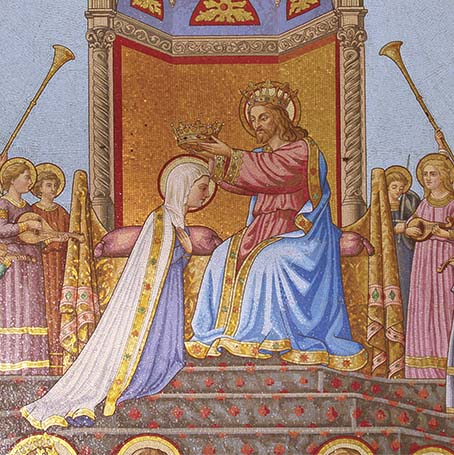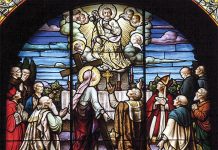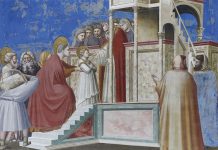Any conception of the triumph of the Immaculate Heart of Mary is but a mere sketch as compared with the wonders that God will work in order to glorify His beloved Daughter, His virginal Mother and His immaculate Spouse.
We would be mistaken to think that the elect, when they depart for Heaven, consider their mission on earth to be over. On the contrary, the true role of those who are saved begins beyond the threshold of eternity. This is what Dr. Plinio Corrêa de Oliveira called the post-history of a soul, even more substantial and efficacious than that of earthly existence, even though the latter may have been outstanding and full of glory.
In view of this, we might well ask ourselves: how does Our Lady’s maternal intervention manifest itself in the events after her Assumption into the heavenly homeland?
For the Author, the post-history of the Blessed Virgin is divided into three great phases: break of dawn, sunrise and radiant midday. The era of the dawn extended from the first times of the early Church to the zenith of the Middle Ages. Sunrise began with the outbreak of the Revolution,1 the nefarious process of deterioration of Christian Civilization that has led to the chaos, atheism and insanity of our days. And the radiant midday will begin with the triumph of the Immaculate Heart of Mary – preceded, as everything indicates, by a chastisement of apocalyptic proportions.
Here we will deal with the last of these stages, namely that of the Reign of Jesus Christ through His Mother.
Glorious future, surpassing all imagining
For the Author, it is impossible to transmit what he carries in his soul about the glorious future reserved for the Holy Catholic Church during the Reign of the heavenly Virgin. He has no words to describe the Church, renewed and resplendent with grace by the action of the Divine Holy Spirit, who will act in its favour in Mary, with Mary and through Mary.
A passage from Baruch’s prophecy offers a pale idea of the intuitions that fill his heart with enthusiasm: “Take off the garment of your sorrow and affliction, O Jerusalem, and put on for ever the beauty of the glory from God. Put on the robe of the righteousness from God; put on your head the diadem of the glory of the Everlasting. For God will show your splendour everywhere under Heaven. For your name will for ever be called by God, ‘Peace of righteousness and glory of godliness’” (5:1-4).
However, the plan of the Most High will surprise even souls of the greatest insight, for He “is able to do far more abundantly than all that we ask or think” (Eph 3:20). Anything that can be imagined about the triumph of Mary’s Heart and the consequent exaltation of the Church are but a mere sketch of the marvels which the Lord of Hosts will perform in order to glorify His beloved Daughter, His virginal Mother and His immaculate Spouse.
Desires that hasten the divine intervention
This sublime reality does not, however, exclude another even more beautiful one, pointed out by Dr. Plinio: “As the just gradually form an idea of what the Reign of Mary will be like, it draws nearer to us.”2 It is proper to prophetism not only to foresee and announce, but in some way to hasten and even to have a foretaste of events detected from afar.

On receiving the news that a small cloud resembling a man’s hand was rising on the horizon, Elijah predicted the torrential rain that would fall on Israel and revitalise the soil made barren by the implacable drought with which God had punished the sins of the people for three years. He immediately sent word to King Ahab to return to his palace without delay, to avoid being stopped by the rain on his way (cf. 1 Kgs 18:41-46).
Beyond the physical phenomenon, the fiery prophet also discerned in the little cloud a prefigure of the Virgin who would bring to earth another deluge, not of water but of grace: the very Divine Source of grace, who would redeem the human race made sterile by the disobedience of our first parents. And Blessed Anne Catherine Emmerich3 says that, choosing three of his disciples, Elijah sent them as messengers to the pagans of the north and of the south, even as far as Egypt, to announce to them that they should prepare themselves, for a Virgin was coming from whom the Saviour of humanity would be born.
This episode shows that when certain souls are taken up by the wind of grace to soar in the firmament of Our Lady’s future exaltation, they must let themselves be led fearlessly. Although they always fall short of the reality, their ardent desire to see the honour of the Mother of God avenged hastens the manifestation of divine justice and mercy.
Accordingly, the Author wishes to offer some considerations regarding the future, based on the prophetic commentaries of his spiritual master, Plinio Corrêa de Oliveira. He thereby wishes to reinforce the inspirations of grace that speak within souls, urging them to confidently await the divine intervention in events that will bring about the end of revolutionary domination and the establishment of the Reign of Jesus through Mary.
“Souls will breathe Mary”
In Dr. Plinio’s prophetic expectation, the Marian era will be a time of bestowal of unprecedented celestial gifts: “It is my hope that Our Lady will give us unimaginable, highly augmented gifts, so much more beautiful and more admirable than those already known, that we are left speechless.”4 Now, for such a communication of graces and designs to be realized, humanity must follow the same path trod by Mary Most Holy: that of Sacred Slavery.
In the Reign of the Virgin, humanity will participate to a high degree in the love that unites the Divine Holy Spirit with Our Lady. According to the expression of St. Louis de Montfort, “souls [will] breathe Mary,”5 that is, they will feel they are the object of her unfathomable and gratuitous love, and as a result will love Her with confidence, fervour and tenderness. From this ineffable affection will spring a mutual discernment of spirits, through which they will contemplate in each other the specific aspect of the Mother of God that each is called to reflect.
However, this will only be accomplished through a very intimate bond of spiritual slavery with the Sovereign of the Universe, entirely composed of enthusiasm, veneration and tenderness, as well as a radical disposition for service, obedience and holocaust. In this way, the whole of society will be raised to a new plateau of the supernatural life, fulfilling entirely the words of St. Paul: “if any one is in Christ, he is a new creation” (2 Cor 5:17). The whole of Public Opinion will radiate the image and likeness of Jesus through Mary’s Universal Mediation.
Reign of clemency, love and sweetness
From this perspective, how should the Reign of Mary be defined?

at Tabor House, in June of 2015
It will be the reign of the clemency, love and sweetness of Our Lady, the historical era in which her spirit will be present in every creature and her love will cover, like a white and discreet mist, the whole earth. Just as today the pestilent and filthy breath of the Revolution is inhaled everywhere, characterized by revolt, egalitarianism and unbridled sensuality, during the Reign of Mary the delicate perfume of the presence and virtues of the heavenly Queen will be breathed, both in souls and ambiences, as well as in customs and even in civilizations.
The great prophet and apostle of Mary, St. Louis de Montfort,6 explains that in the souls of the paladins of her reign, Our Lady will engender such a superior sanctity – it being a participation in her own virtues – that they will be, in the order of grace, like cedars of Lebanon compared with the shrubs that were the Saints of previous eras.
To these elect She will show and give herself completely, as never before. There will be a moment when each one of her children and slaves will see Her as if transfigured before them and will experience the torrents of love and mercy that emanate from her Heart. All will be cleansed, forgiven and restored. The Reign of Mary, the utmost realization of the Reign of Christ, will be founded in souls.
The Secret of Mary will be revealed
This apogee of supernatural vitality will make the Church and society an image of the glorious Body of Christ. Substantially it will always remain the one and same Mystical Body, but it will be adorned with new qualities, which will impart to it a most intense light. Man will continue to be subject to the evil tendencies instilled by original sin; however, it is to be expected that that these, in most cases, will remain subject to reason illuminated by faith as a result of an extraordinary motion of grace granted by divine mercy.
To achieve this degree of sanctification and renewal of His Mystical Spouse, Our Lord will do for humanity something analogous to what was done for the disciples in the days after Easter Sunday: He will open their minds so that they may understand the Scriptures (cf. Lk 24:45). Then the Secret of Mary7 will be revealed, which involves a truth that is known, but not fully understood and loved. In this regard, Dr. Plinio states:
“I have the impression, while not having the certainty, that the Secret of Mary will be a new light on a previously manifested truth, but whose interpretation will be particularly striking in this period of history. This truth, contained in official Revelation, would concern the very essence of God and, from there, God’s relationship with Our Lady, the Church and all souls. Consequently, humanity’s relationship with the universe – in the cultural, political, social and economic spheres – would be profoundly conditioned by this new perspective, on which a special light would be shed.”8

Dr. Plinio Corrêa de Oliveira
Nevertheless, the Secret of Mary will not be limited to the simple assimilation of a truth, although this is necessary, since one cannot love what one does not know. A clear notion concerning Our Lady will produce in hearts an effect similar to that experienced by the disciples on the road to Emmaus when they heard the teachings of the Divine Master: “Did not our hearts burn within us while He talked to us on the road, while He opened to us the Scriptures?” (Lk 24:32).
By an action of grace, this perception will be accompanied by an increase of love, devotion and piety towards Her, which will result, as Dr. Plinio points out, in “a certain union of thoughts and actions with Mary and, through Her, with Jesus. How this will be we cannot now understand. It is something sublime and mysterious.”9
A new civilization will arise from these graces
The full revelation of this Secret will open minds and hearts to two specific aspects of Our Lady. On the one hand, there will be a extraordinary deepening into the comprehension of her relationships with the Three Divine Persons, as mentioned above. In the light of this relationship, the union among souls will attain such a calibre that, as Dr. Plinio explains, “a kind of peace and tranquillity would be established among men, giving rise to a new civilization.”10 And, more especially, “a relationship with the Hearts of Jesus and Mary would be inaugurated, marked by a note of intimacy previously unknown.”11
On the other hand, as a consequence of a theological development favoured by special graces and perhaps mystical gifts, the Universal Mediation of Our Lady and her role in the salvation of humanity will become evident, highlighting the super-excellence of her sanctity. As a corollary, light will be shed on the enigmatic revolutionary process and the false prophets that sustain it, which have enveloped the Church in darkness.
Dr. Plinio also points out that “this new understanding would open such a breadth of grace for men, would give such a filial and, at the same time, humble character to the bond with Her, that it would raise the level of piety of the faithful and, a fortiori, of the clergy to a height only vaguely envisioned by previous ages. Thus, when the moment comes for the revelation of the Secret of Mary, our hopes for sanctity will multiply a millionfold!”12
As a result, good will be exalted as never before, and evil will be execrated to the fullest extent. As this blessed age progresses and reaches its apogee, the foundations will be laid so that the honour due to the Creator is fully rendered, thereby bringing history to a glorious end. ◊
Taken, with slight adaptations, from:
Maria Santíssima! O Paraíso de Deus revelado aos homens.
[Mary Most Holy! God’s Paradise Revealed to Men]
São Paulo: Arautos do Evangelho2020, v.III, p.59-67; 117-129
Notes
1 It may be perplexing to qualify as sunrise a period that is distinguished by the systematic demolition of Christian values and the decadence of the Church itself, wounded by the sins of her children. However, in the midst of the battles of the Bride of the Lamb against the gnostic and egalitarian Revolution, men and women emerged whose virtue contained a strength and splendour characteristic of and foreshadowing a historical period of outstanding sanctity. St. Louis-Marie Grignion de Montfort, for example, is a Saint who far transcends his own time, fully worthy of the Marian era he himself announced.
2 CORRÊA DE OLIVEIRA, Plinio. Talk. São Paulo, Dec. 19, 1981.
3 Cf. BLESSED ANNE CATHERINE EMMERICH. Visiones y revelaciones completas. Madrid: Ciudadela Libros, 2012, v.II, p.316.
4 CORRÊA DE OLIVEIRA, Plinio. Conversation. São Paulo, Jan. 6, 1981.
5 ST. LOUIS-MARIE GRIGNION DE MONTFORT. Traité de la vraie dévotion à la Sainte Vierge, n.217.
6 Cf. Idem, n.47.
7 In his writings, St. Louis de Montfort refers to the slavery of love for Mary which he proclaimed as a secret revealed by the Most High of a sure way to holiness. More than in pious practices, this secret consists in doing all things with Mary, in Mary, by Mary and for Mary (cf. ST. LOUIS-MARIE GRIGNION DE MONTFORT. Le secret de Marie, n.1; 28).
8 CORRÊA DE OLIVEIRA, Plinio. Talk. São Paulo, July 28, 1980.
9 CORRÊA DE OLIVEIRA, Plinio. Talk. São Paulo, Aug. 30, 1986.
10 Idem, ibidem.
11 Idem, ibidem.
12 CORRÊA DE OLIVEIRA, Plinio. Conversation. São Paulo, Apr. 28, 1987.







